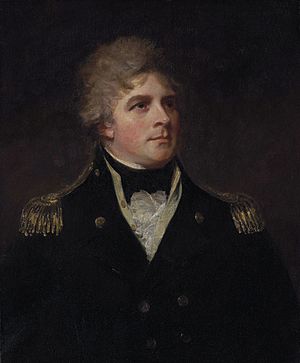Sir John Orde, 1st Baronet facts for kids
Quick facts for kids
Sir John Orde
|
|
|---|---|
 |
|
| Born | 22 December 1751 |
| Died | 19 February 1824 (aged 72) |
| Allegiance | |
| Service/ |
|
| Years of service | 1766–1824 |
| Rank | Admiral |
| Battles/wars | |
| Spouse(s) |
Margaret Emma Stephens
(m. 1781; Jane Frere
(m. 1793) |
| Other work | Member of Parliament for Yarmouth |
Sir John Orde, 1st Baronet (born December 22, 1751 – died February 19, 1824) was an important officer in the British Royal Navy. He was the third son of John Orde and the brother of Thomas Orde-Powlett, 1st Baron Bolton. Sir John Orde is often remembered for his professional disagreements with another famous naval hero, Admiral Nelson. However, his main arguments were actually with Lord St Vincent, not Nelson himself.
Orde joined the Royal Navy in 1766. He rose through the ranks, becoming a rear-admiral in 1795, a vice-admiral in 1799, and finally an Admiral. In 1805, he was made Admiral of the Blue and then Admiral of the White in 1810. As a vice-admiral in 1805, he led a group of six large warships, called a squadron, off the coast of Cadiz, Spain. His main ship was HMS Glory.
Besides his naval career, Orde also served as the Governor of Dominica, an island in the Caribbean, from 1783 to 1793. He was given the special title of 1st Baronet Orde in 1790. Later, from 1807, he became a Member of Parliament for Yarmouth.
Contents
Early Years and Promotions
John Orde began his journey in the Royal Navy in 1766. He quickly showed promise and was promoted to lieutenant in 1774. He served throughout the American Revolutionary War (1775–1783). This was a big conflict where the American colonies fought for their independence from Britain.
On May 19, 1778, Orde was promoted to post captain. This meant he was a captain with command of a ship. Interestingly, he reached this rank just a little before Nelson did. After the war, he took on a different role, serving as the Governor of Dominica from 1783 until 1793. In 1790, he was given the title of a baronet, which is a special honor. He then returned to naval service and was promoted to rear admiral in 1795.
Disagreements with Senior Officers
In 1798, Orde was assigned to the Mediterranean fleet as the third-in-command, working under Lord St Vincent. That same year, Lord St Vincent decided to give command of a special squadron to Nelson. This decision was supported by Lord Spencer, who was in charge of the Admiralty (the Navy's headquarters).
Since Orde was senior to Nelson, he felt he should have been chosen for this important command. He complained to Lord St Vincent, who became annoyed and sent Orde home. Orde then asked for a court-martial, a military trial, to clear his name, but the Navy Board refused. He then asked for Lord St Vincent to be court-martialed, but this was also refused. The Board did, however, criticize Lord St Vincent for not supporting his officers better.
Orde was still unhappy and challenged Lord St Vincent to a duel. A duel was a formal fight, often with pistols, to settle a dispute. When the king heard about this, he ordered Lord St Vincent to refuse the challenge. Before the refusal was official, Orde decided to withdraw his challenge. This whole situation was difficult for both officers. If Nelson hadn't won such a huge victory at the Battle of the Nile shortly after, Lord St Vincent might have faced more trouble. Nelson naturally sided with Lord St Vincent and saw Orde as an opponent. However, Orde always said his objection was about the principle of the appointment, not about Nelson personally.
Things got even harder for Orde when Lord St Vincent became the First Lord of the Admiralty, the most powerful position in the Navy. This meant Lord St Vincent controlled who got important commands, and Orde found himself without a ship. When Lord St Vincent left the Admiralty in 1804, Orde was finally offered command of a new squadron off Cadiz. This decision, however, made Nelson even more upset, as he saw it as a way to reduce his own authority.
The Spanish Squadron and Retirement
In April 1805, Sir John Orde's squadron of six warships was stationed off Cadiz. At that time, a French fleet led by Admiral Villeneuve arrived. Orde's ships were busy getting supplies, but they quickly prepared for battle. Villeneuve, with his much larger fleet of eleven warships and six frigates, chose not to attack Orde's smaller squadron.
Since he was greatly outnumbered, Orde decided to retreat. Some people, including Nelson, criticized him for this. Orde believed Villeneuve's fleet was heading for the English Channel, so he took his squadron north to meet up with the British Channel Fleet. While his decision was technically correct, it didn't match the mood of the country, which expected aggressive action. Because of this, he was ordered to "strike his flag," which meant he was removed from command at sea. He never served at sea again after this.
In 1807, Orde became a Member of Parliament for Yarmouth, Isle of Wight. He served in this role until his death on February 19, 1824. Despite their past disagreements, Orde did not seem to hold a grudge against Nelson. In fact, he was one of the pall-bearers at Nelson's funeral in January 1806, helping to carry his coffin.
Family Life
Sir John Orde was married twice during his life. His first marriage was to Margaret Emma Stephens in 1781. Sadly, she passed away in 1790. He then married Jane Frere in 1793. They had two children together:
- John Powlett Orde, born on June 9, 1803.
- Anna Maria Fenn Orde, born in 1806.

